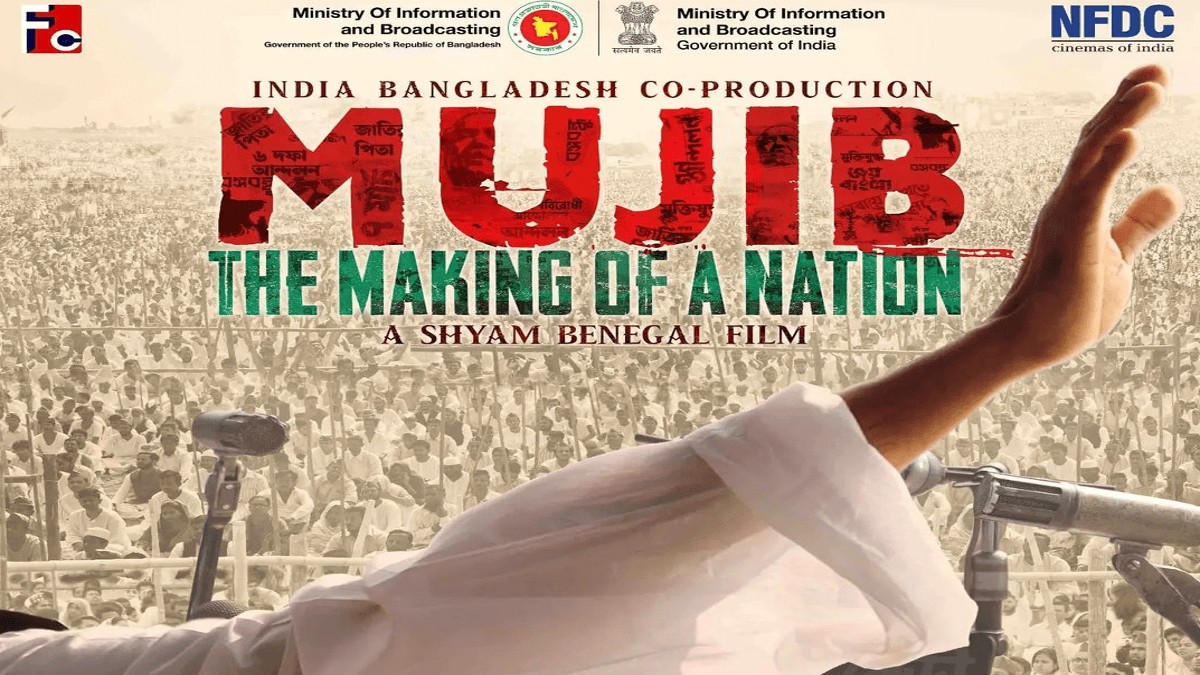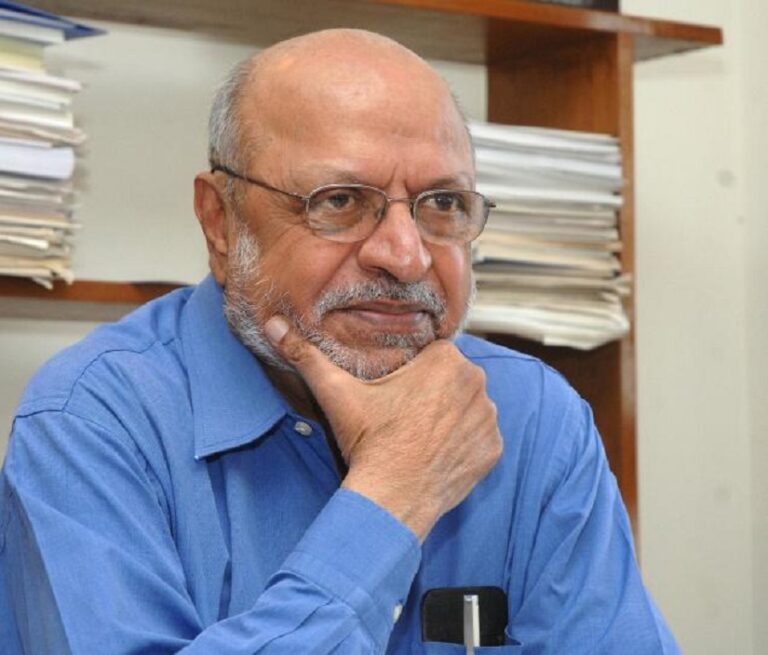“WHEN YOU ARE MAKING A FILM, THE AUDIENCE IS NO ONE ELSE BUT YOU”
Shyam Benegal is one of the most outstanding filmmakers in the history of Indian cinema. He is now 88 years of age, and though he does not talk about this, the ageing shows in his talk, his walk and in his infrequent presences at film premieres and functions. He ran a very successful ad film company called Blaze which also produced his film Ankur but he has moved on since then and also won the Dadasaheb Phalke Award for his rich and long-standing contribution to cinema from the hands of the then-President, Pratibha Patil. Mujib – The Making of a Nation is a BFDC-NFDC collaboration between India and Bangladesh to place on record, the life, and tragic death of Sheikh Mujibur Rehman, the first Prime Minister and President of Bangladesh. Benegal, who is also a member of the Rajya Sabha, was earlier bestowed with Padma Shri in 1976 and Padma Bhushan in 1991. The film has opened to mixed reviews but has hit the box office in Bangla Desh.
After a long hiatus, Benegal attended the gala premiere of the film held in Mumbai of probably his most expensive film to date – Mujib – The Making of a Nation. His first feature film in Hindi, Ankur (The Seedling, 1973), tells the story of an arrogant urban youth who returns to his ancestral home in feudal Andhra Pradesh. His subsequent affair with the wife of one of his labourers (played powerfully by Shabhana Azmi in her debut) and her eventual call to arms against the feudal system brought him criticism for using a purportedly “un-Indian” approach and for “victimizing” women. The film brought the problem of feudal and patriarchal structures to the fore. He followed this with dozens of films which are known for their subtlety of treatment, excellent cinematic technique and powerful socio-historical-political statements.
What is it about cinema as a medium of expression that attracts you?
Cinema uses elements practically from all the different arts – literature, painting, music, photography, dance, mime, movement and poetry. This is what attracts me to cinema. It allows you to explore all the arts while you are actually making a film, or, while you are working towards making a film.

Do you have a specific audience in mind – Indian, international, – when you are making a film? Is there a difference in approach if you have a special audience in mind?
When you are making a film, the primary audience of the film is no one else but you. At that point of time therefore, you do not think in terms of an international audience. But a film is complete only when the audience sees it. If you are thinking of an audience before you make a film, you are turning your film into a commodity even before you have made it. You are looking at it as a saleable commodity and this will bring along its own compulsions. I do not care for the kind of film where market factors manipulate my creative expression. There is certainly a difference between and Indian and an international audience. There are cultural and linguistic differences apart from differences in body language, manner of communications and so on. Semiotics, signs and symbols differ from culture to culture. But at another level, cinema also crates uniformity in communication that can be understood by all. Hollywood for instance has acquired the ability to communicate with the world audience. So, Hollywood films have a world market.
Given a choice, what would you choose?
I believe that the essential source of creativity and or art lies in the specificity of the culture it is born into and belongs to. Creative artistic expression must be culture-specific. Exceptions to this are masters of cinema like Charlie Chaplin, Akira Kurasawa and Satyajit Ray who could communicate with everybody through their films. Standardization and uniformity in my opinion, militate against true artistic expression.
Given that we live in a developing economy, do you feel that a filmmaker should play a direct, social role like Eisenstein did in Russia? Or do you believe that since a filmmaker is essentially a creative artist, he should be free to pursue his art the way he likes?
Whether creative people play a social role or not depends on the kind of compulsions society forces on them. Under certain social conditions, as a filmmaker, you find yourself reacting to those conditions whether you like to react to them or not. Artistic inclinations sometimes have to do with individual compulsions. At other times, they have to do with social compulsions while there are historical compulsions sometimes that propel a filmmaker to move in a certain direction. Lenin for example, thought and believed cinema to have an important revolutionary role to play. Early Soviet filmmakers like Eisentein used cinema as a means of social and militant transformation as a given part of thinking of Soviet Communism. In Brazil on the other hand, the new cinema used cinema as a means to destroy the Establishment. So, at the end of the day, a filmmaker acts according to what his compulsions are at a given point of time. He is not just a reactive individual. Being creative is being more than just a reactive person.
Many of your films offer an empathetic insight into the conditions of women. What triggers this empathy?
There may not be a definite trigger every time. It is not as if I want to always present women as victims. There is something very interesting about women, particularly in India, because the social pressures on them are so much more than on men due to the way Indian society is. What I intend to show is the ability of Indian women to handle the situations they have been placed in.
You have also been quite empathetic to secular modes of thinking looking at the way you have treated minorities in some of your films. Right?
Right. The demolition of the Babri Masjid in December 1992 and the Mumbai riots that followed in its wake in January 1993 motivated me to respond to my feelings for the minority community. My empathy for the minority was triggered mainly by the violence I was personally witness to at the crowded streets of Tardeo where my office stands. I saw a Muslim bakery being set on fire by an angry mob. I made three films in quick succession – Mammo, Sardari Begum and Zubeidaa, a family trilogy relating to the stories and journeys of three women from Muslim families. The first of these, Mammo, was in response to an article penned by Khalid Mohamed, then-editor of Filmfare and film critic of Times of India. It was about a great aunt of Mohamed that moved me. I sought Mohamed out and thus began a strikingly unusual collaboration between a filmmaker and a film critic, leading to the making of not one, but three films. I have not done anything consciously. These choices simply happened as I was not brought up on ideas of discrimination be it gender or communal beliefs.
Tell us something more about Mujib – The Making of a Nation.
We have our own native prejudices. You must open up to all these things and eliminate the prejudices. You must wipe out or keep behind you, these prejudices you have built across time and space, how things happened, what positions were taken, what made India finally go to war with Pakistan and so on. Was it because Bangladesh was fighting for its freedom? Or were we helping them so that they could help us? The subject is filled with political connotations and interpretations. We must always remember that we had 10 million refugees across our border.It was not our problem to begin with but over time, we realized that it had actually become our problem as they had crossed the borders and were now living in India. I did not expect the film to have such a hyped and huge release in Bangladesh. So it felt like a miracle when it opened to 170 theatres in Bangladesh each show running to a full house and then opening more screenings and more theatres. It was incredible to me.
How did you manage the language barrier considering you are not a Bengali and do not know the language, specially the Bangladeshi dialect which has its own cadences and accents differing from place to place?
I had a lot of help from Bangladeshis both from films and from the world out there. Bangladeshi Bangla is quite different from the Bengali people speak in India. But the locals helped me in overcoming issues with language. I also decided to use the narrative voice-over by the actress who played the role of Mujib’s wife Renu though she was not present or even an eye-witness to many events. Above all, I found the music to be more varied in nature than in this part of Bengal. Besides, since Bangladesh is full of rivers, the lives of the people are inevitably and irretrievably linked to their lives, their culture, their music and dance and everything else. For me, it was quite an enriching and learning experience.


 Shoma A. Chatterji is a freelance journalist, film scholar and author. She has authored 17 published titles and won the National Award for Best Writing on Cinema, twice. She won the UNFPA-Laadli Media Award, 2010 for ‘commitment to addressing and analysing gender issues’ among many awards.
Shoma A. Chatterji is a freelance journalist, film scholar and author. She has authored 17 published titles and won the National Award for Best Writing on Cinema, twice. She won the UNFPA-Laadli Media Award, 2010 for ‘commitment to addressing and analysing gender issues’ among many awards.